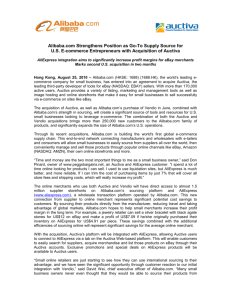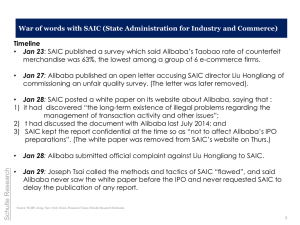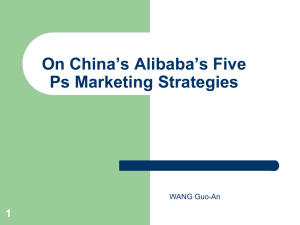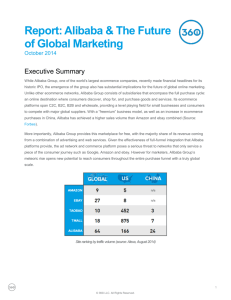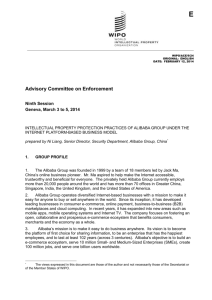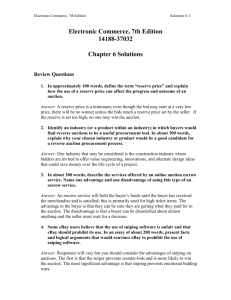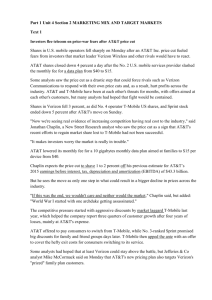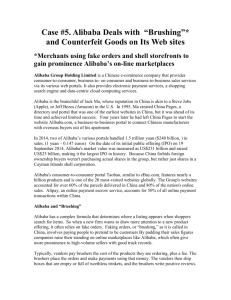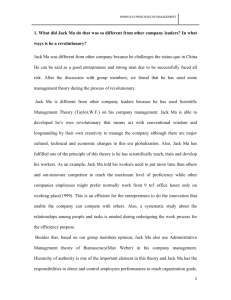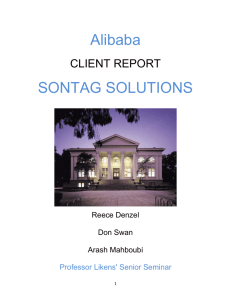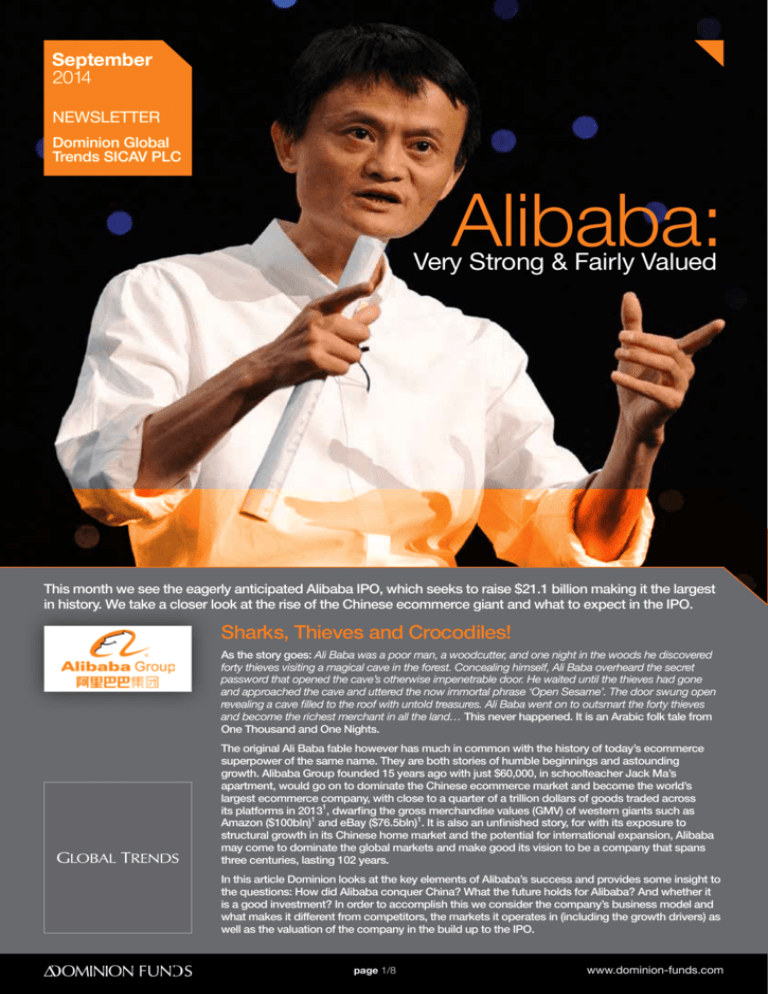
September
2014
NEWSLETTER
Dominion Global
Trends SICAV PLC
Alibaba:
Very Strong & Fairly Valued
This month we see the eagerly anticipated Alibaba IPO, which seeks to raise $21.1 billion making it the largest
in history. We take a closer look at the rise of the Chinese ecommerce giant and what to expect in the IPO.
Sharks, Thieves and Crocodiles!
As the story goes: Ali Baba was a poor man, a woodcutter, and one night in the woods he discovered
forty thieves visiting a magical cave in the forest. Concealing himself, Ali Baba overheard the secret
password that opened the cave’s otherwise impenetrable door. He waited until the thieves had gone
and approached the cave and uttered the now immortal phrase ‘Open Sesame’. The door swung open
revealing a cave filled to the roof with untold treasures. Ali Baba went on to outsmart the forty thieves
and become the richest merchant in all the land… This never happened. It is an Arabic folk tale from
One Thousand and One Nights.
The original Ali Baba fable however has much in common with the history of today’s ecommerce
superpower of the same name. They are both stories of humble beginnings and astounding
growth. Alibaba Group founded 15 years ago with just $60,000, in schoolteacher Jack Ma’s
apartment, would go on to dominate the Chinese ecommerce market and become the world’s
largest ecommerce company, with close to a quarter of a trillion dollars of goods traded across
its platforms in 20131, dwarfing the gross merchandise values (GMV) of western giants such as
Amazon ($100bln)1 and eBay ($76.5bln)1. It is also an unfinished story, for with its exposure to
structural growth in its Chinese home market and the potential for international expansion, Alibaba
may come to dominate the global markets and make good its vision to be a company that spans
three centuries, lasting 102 years.
In this article Dominion looks at the key elements of Alibaba’s success and provides some insight to
the questions: How did Alibaba conquer China? What the future holds for Alibaba? And whether it
is a good investment? In order to accomplish this we consider the company’s business model and
what makes it different from competitors, the markets it operates in (including the growth drivers) as
well as the valuation of the company in the build up to the IPO.
page 1/8
www.dominion-funds.com
September
2014
NEWSLETTER
Dominion Global
Trends SICAV PLC
How a Crocodile Conquered China
The Alibaba of today offers a dazzling number of services. Ranging from cloud computing platform Aliyun
with over 1 million customers, wholesale marketplaces (1668.com and Alibaba.com), messaging services,
a payment network (AliPay) to its vital retail online marketplaces Taobao, TMALL and Juhuasuan. The latter
combined generate 84.5% of the Company’s $8.5 billion revenue. However, it was not always this way.
China Retail Marketplaces
Taobao Marketplace
(Online shopping destination)
AliExpress
(Global consumer marketplace)
Tmall.com
Juhuasuan
(Brands and retail platform)
(Group buying marketplace)
Alibaba.com
1688.com
(Global wholesale marketplace)
(China wholesale marketplace)
Mr Jack Ma
Alipay (Payment services)*
China Smart Logistics (Logistics information system)**
Alimama (Online marketing services)
Data Platform
Alibaba Cloud Computing (Platform for internal and third-party use)
Exhibit 1: Graph outlining services offered by Alibaba Source: Company filing
When Alibaba was founded it had but one small site,
Alibaba.com, which focused on connecting small Chinese
manufacturers with overseas wholesale buyers. If it had stayed
as such it would just have been a footnote in Chinese corporate
history, another middling company perhaps. However, the
defining moment in Alibaba’s explosive growth came when
Mr Ma’s focus turned towards serving the demand of China’s
page 2/8
rapidly growing and newly affluent middle class. In 2003 he
launched Taobao - which translates as ‘search for treasure’ a consumer to consumer (C2C) marketplace similar to eBay’s
eponymous online marketplace. This change of focus proved
to be smart given that consumption is today 36.5% of China’s
$17.9 trillion GDP.
“eBay may be the shark in the
ocean but I am the crocodile in the
Yangzi. If we fight in the ocean,
we lose; but if we fight in the river,
we win”. Mr Jack Ma
Yangzi River, Crocodile
However the sector was already occupied by eBay, who through
its partnership with Eachnet controlled a market share of around
70% of the C2C landscape in China. Mr Ma famously remarked
“eBay may be the shark in the ocean but I am the crocodile in the
Yangzi. If we fight in the ocean, we lose; but if we fight in the river,
we win”. He was right: today Alibaba has a market share
of 96.5% in the C2C market and 50.1% in the business
to consumer market. How did the crocodile defeat the shark?
In the fairy tale Ali Baba defeats the 40 thieves with the help
of a slave, a healthy measure of cunning and a lot of burning oil.
Given that these are no longer considered acceptable business
practices we must look elsewhere for the key to Mr Ma’s
success, specifically the company’s business model and its
key elements: an appreciation for Chinese consumer culture,
the prioritising of trust in ecommerce, a better price and an
asset light infrastructure.
My Culture is your Culture
“Chinese consumers like busy web designs with strong colours.
Westerners prefer sparse sites like Google’s, but Chinese customers
want their websites to be noisy, with lots of links.” Zhang Yu, vice
president of marketplaces at Taobao.
Taobao is a Chinese platform. This extends beyond the nationality
of its employees or customers to the identity of its brand and its
platform design. The website design was carefully crafted in order
to provide ease of use and immediate familiarity for the Chinese
consumer. Red and Orange are the brands primary colours
symbolising festivity and prosperity. Similarly the layout of the
website is full and busy with every space filled with information
or pictures differing markedly from the more minimalistic western
approach which eBay had exported to China. This sent a clear
message; “we are Chinese and proud!” and allowed for early
differentiation from their larger foreign rivals.
Exhibit 2: Screen shot of Taobao layout. Source: Google Images
page 3/8
www.dominion-funds.com
September
2014
NEWSLETTER
Dominion Global
Trends SICAV PLC
Trust Me I Am A Website
The underlying foundation in all commerce - electronic or
otherwise - is trust. Simply put, both the buyer and seller must
believe they will not suffer from fraud. While familiarity breeds
comfort it does little to inspire trust in a user. Therefore in order
for Alibaba to create a sizable user base it had to convince
people that they provide a secure service. eBay and Amazon
originally provided this in the home markets through either
escrow payment (eBay’s PayPal) or the secure logistics chain
of Amazon’s owned distribution. Alibaba, however, had to
go further. It was, and still is, serving a population with a low
internet penetration (only 6.8% in 2003) that was far less familiar
and less trusting of the internet.
Accordingly, it is of little surprise that Alibaba has security fraud
prevention and consumer protection woven into its business
model. They offer flexibility in payments: with cash on delivery
one of the options that eliminates receivership fraud and
provides an easy bridge to ecommerce for new users. Though
the majority of payment volumes (79%) flow through AliPay, an
electronic payment platform created by Alibaba, which has the
ability to hold cash in escrow and return it to the buyer should
a dispute be resolved in the purchaser’s favour. Through these
measures Alibaba has been able to convince over 230 million
Chinese to use their site and the company records that disputed
transactions are less than 0.08% of all orders.
For a company to break into a market and take customers from
its rivals it must offer, or at least be perceived to be offering,
either a better service or price. In the case of Alibaba it offered
both across its online retail marketplaces of Taobao, and latterly
TMALL (a platform for established consumer brands) and
Juhuasuan (a group buying platform). However, the company’s
key differentiation was the tools it provided to sellers and the
price it charged for these tools.
On Alibaba’s platforms vendors create virtual storefronts, free
websites, within the Alibaba web domain using tools and a
virtual infrastructure provided by Alibaba. These pages would
then be searchable through an Alibaba indexing algorithm. This
search, explore and discover functionality allowed the company
to provide search results, suggestions and most importantly
advertising to buyers across its ecosystem, in a very similar
way that Google does for users of its search engine. In essence
Alibaba had created its own corner of the internet, a Chinese
Walled Garden.
page 4/8
The Walled Garden of the worldwide web
This system
fulfilled more than
5 billion packages
in 2013, 0.7 billion
more than the entire
UPS global
network in the
same year and
54% of all deliveries
in China over the
same year.
Exhibit 3: A Flowchart outlining Alibaba’s Market Place Offering.
Source: Company Filing
The company then offered a revolutionary pricing scheme
for its C2C business, Taobao. Traditional ecommerce models
relied on commission charged on sales. Taobao, by contrast
is completely commission free. Instead the company charges
merchants for upgrading their storefronts and advertising within
the Alibaba ecosystem and search engine. This freemium
pricing model provided a strong tailwind to merchant acquisition
which in turn drew more consumers. This led to a virtuous circle
- known as the Network Effect - as more sellers join due to the
high volume of consumers using the platform and vice versa.
These buyers now had an Alibaba account which could be
used across all their platforms, the Alibaba ecosystem, allowing
cross-selling opportunities and boosting user numbers for
commission charging platforms such as TMALL
and Juhuasuan.
The numbers speak for themselves. Through a compelling
combination of cultural awareness, a secure platform,
page 5/8
networking effects and improved pricing and services Alibaba
already has nearly one quarter of a billion buyers who are on
average each placing 49 orders a year - for a combined total
of 11.3bln per annum - with 8 million vendors.
This provides a logistical challenge as these orders need to
be fulfilled. Alibaba’s asset light business philosophy expands
into its logistics. The company owns no physical logistical
infrastructure but rather outsources to 14 chosen third party
logistics companies, termed delivery partners. Together they
employ more than 950,000 delivery personnel in over 600 cities.
Orders are processed and channelled through a joint venture
logistics platform, China Smart Logistics. This system fulfilled
more than 5 billion packages in 2013, 0.7 billion more than the
entire UPS global network in the same year and 54% of all
deliveries in China over the same year.
www.dominion-funds.com
September
2014
NEWSLETTER
Dominion Global
Trends SICAV PLC
Exhibit 4: EBITDA and EBITDA
Margin, 2014 onwards forecasts.
Source: Company Filing,
Dominion Model.
EBITDA (USD Millions)
EBITDA Margin
Scalable Business:
Growth = higher margins
Alibaba’s capital light business structure enabled the
company’s rapid growth. Indeed the only significant
investment in physical assets the company has to
make is in data centres to support web operations.
This means that as Alibaba grows it has to make very
little incremental investment to support the additional
revenue. The upside to such a scalable business model
is that as sales increase, so do margins as the company
generates operational leverage against the sunk cost of
R&D investment. The graph above illustrates the near
doubling of the post-tax operating margin.
However, the flip side of such a business model is
that a company must maintain their focus on R&D and
technical spending in order to maintain its network
and technological edge. Currently this appears to be
the case: Alibaba have 48% of its 20,884 workforce
dedicated to these tasks, either in engineering (35%)
or web operations (13%).
Growth Drivers: A Technological and
Demographic Perfect Storm
Alibaba’s growth has been nothing short of spectacular
with 72% and 52% revenue growth in 2012 and 2013
respectively, while profits have grown 157% and 88%
over the same periods. To understand how the Company
grew so fast and to glean future growth opportunities we
must also consider the structural growth drivers in the
company’s key market.
There are two elements to economic growth:
demographics and productivity. The former is
concerned with population size and make up, while the
latter with technology and workforce efficiency. Similarly
we can split Alibaba’s growth along demographic and
technological lines.
page 6/8
“The right
thing at the
wrong time
is the
wrong thing.”
Joshua Harris
Alibaba launched its first consumer focused site in 2003.
This displays either a considerable amount of foresight
or extreme good fortune, as the millennium marked the
new beginning of a Mega Trend which will change the
world - The Rise of Emerging Market Consumers. By the
end of 2003 China’s GDP per capita was $1,490, by 2013
it had more than tripled to $6,560. This meant that those
formerly on a subsistence lifestyle were moving to cities,
finding higher paying jobs, joining the middle class and
starting to spend on discretionary items. This proved a
strong structural growth tailwind for consumer focused
companies such as Alibaba.
Chinese Internet Population
700
600
500
400
300
200
Though this trend is very much still in motion, it is fair
to argue it is no longer the largest factor affecting the
growth of Alibaba. The rise of ecommerce is now the
dominant influence as more and more people come
online in China. In 2008, 298 million Chinese had access
to the internet. Today China boasts the world’s largest
online population with 618 million people online out of a
population of 1.37 billion, therefore a penetration of 45%.
By 2016 the online population of China is forecast to grow
to 790 million, an increase of 27%, driving penetration
close to 60%, still below the developed world average of
circa 85%. Currently only 49% of Chinese internet users
shop online, spending some $300 billion or 7.9% of total
Chinese consumption. However online shopping spend
is forecast to more than double by year end 2016 to
$611 billion - 11.5% of consumption - online penetration
and ecommerce adoption continues to increase as
smartphones become increasingly pervasive across the
Middle Kingdom (Alibaba already has 136 million mobile
users) and urbanisation continues.
100
If in the long-term we assume China can reach western
levels of penetration - both in internet and online
shopping - one could expect an online population of
1.16 billion people with 870 million online shoppers
spending some $1.36 trillion per annum. This implies that
the market - even with conservative spend per capita
penetration - can more than double again after 2016,
providing Alibaba with a high growth home market for
many years to come.
300
0
Shopping (USD Billions)
Online Shopping in China (UDS Billions)
900
100%
800
80%
700
600
60%
500
400
40%
200
20%
100
0%
0
EBITDA (USD Millions)
EBITDA Margin
Exhibit 5: Chinese ecommerce drivers.
Sources: CNNIC for 2008-2013, iResearch for 2014-2016
page 7/8
www.dominion-funds.com
September
2014
NEWSLETTER
Dominion Global
Trends SICAV PLC
Good company does not a Good Investment Make
Renowned investor Warren Buffet once said, “It’s far better to buy a wonderful company at
a fair price than a fair company at a wonderful price.” Throughout the preceding course of
this article we have laid out the strengths and weaknesses of Alibaba and it is fair to say that
it is a strong company.
However, given that its forthcoming IPO is the most hyped of the year and has the potential
to become the largest tech IPO ever - overtaking Facebook’s IPO - it is highly unlikely that
the Crocodile of the Yangtze will list for a ‘wonderful price’. Therefore we must ascertain what
a fair price would be that could justify an investment.
Using a discounted cashflow model we calculate the company to be valued at $174.5 billion
($72.69 per share). However this method neglects any premium (or discount) that
the market may apply to the company. Given its higher margins, strong net cash fiscal
position and enviable incumbent position one could reasonably argue that Alibaba is
deserving of a premium against its peer group. This is in spite of questionable decisions
made by management in the past including the hiving off of AliPay in 2011 as a separate
non connected entity or the purchasing of half of Gaungzhou Evengrande football club.
A peer group of leading Chinese ecommerce companies, including the likes of JD.com,
Tencent and Baidu offer valuation benchmarks and suggest a valuation of around $162 billion
($67.50 per share) for Alibaba. This would be close to the top end of $66 to $68 per share
initial pricing of the company and suggests that the timing of the IPO is beneficial to selling
shareholders. If the company does price at the top end of the range then some will deem
this unattractive and will opt instead to invest in Yahoo which currently holds 24% of
Alibaba shares.
However, as the company prices, one thing is not in doubt; the Crocodile of the Yangzi River
is about to leave China and make its mark in the world.
“It’s far better to
buy a wonderful
company at a
fair price than a
fair company at a
wonderful price.”
Investor Warren Buffet
1. Source: Company Accounts
© 2014 Dominion Fund Management Limited (“DFML”). All rights reserved.
DFML is licensed by the Guernsey Financial Services Commission under the Protection of Investors (Bailiwick of Guernsey) Law 1987, as amended. DFML is a member of the
Dominion Group of companies. Registered Office: Ground Floor, Tudor House, Le Bordage, St Peter Port, Guernsey, GY1 1DB. Company no. 42592
page 8/8
GTC-ALINEWS-SEP2014
Yangzi River, China
www.dominion-funds.com

